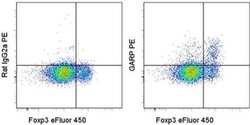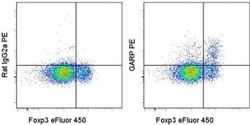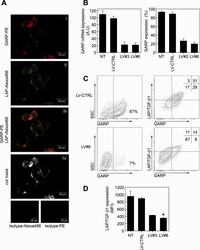Antibody data
- Antibody Data
- Antigen structure
- References [4]
- Comments [0]
- Validations
- Flow cytometry [2]
- Other assay [1]
Submit
Validation data
Reference
Comment
Report error
- Product number
- 12-9882-42 - Provider product page

- Provider
- Invitrogen Antibodies
- Product name
- GARP Monoclonal Antibody (G14D9), PE, eBioscience™
- Antibody type
- Monoclonal
- Antigen
- Other
- Description
- Description: The G14D9 monoclonal antibody reacts with human Glycoprotein A Repetitions Predominant (GARP, also known as LRRC32 or Garpin). GARP is an approximately 80 kDa glycoprotein that is expressed on the cell surface. Using northern blot, RT-PCR or microarray analyses, the expression of GARP has been reported in placenta, lung, kidney, heart, ovary, liver, skeletal muscle, and pancreas. Protein expression has been observed on megakaryocytes, platelets and activated regulatory T (Treg) cells. The expression of GARP on the surface of activated Treg cells has been reported to be necessary for their suppressive function, possibly related to its role as a cell surface receptor for LAP/TGF beta. Applications Reported: This G14D9 antibody has been reported for use in flow cytometric analysis. Applications Tested: This G14D9 antibody has been pre-titrated and tested by flow cytometric analysis of stimulated normal human peripheral blood cells. This can be used at 5 µL (0.5 µg) per test. A test is defined as the amount (µg) of antibody that will stain a cell sample in a final volume of 100 µL. Cell number should be determined empirically but can range from 10^5 to 10^8 cells/test. Excitation: 488-561 nm; Emission: 578 nm; Laser: Blue Laser, Green Laser, Yellow-Green Laser. Filtration: 0.2 µm post-manufacturing filtered.
- Reactivity
- Human
- Host
- Rat
- Conjugate
- Yellow dye
- Isotype
- IgG
- Antibody clone number
- G14D9
- Vial size
- 100 Tests
- Concentration
- 5 μL/Test
- Storage
- 4°C, store in dark, DO NOT FREEZE!
Submitted references A distal enhancer at risk locus 11q13.5 promotes suppression of colitis by T(reg) cells.
Mesenchymal stromal cells express GARP/LRRC32 on their surface: effects on their biology and immunomodulatory capacity.
Impaired circulating CD4+ LAP+ regulatory T cells in patients with acute coronary syndrome and its mechanistic study.
Phenotypic and functional characteristics of CD4+ CD39+ FOXP3+ and CD4+ CD39+ FOXP3neg T-cell subsets in cancer patients.
Nasrallah R, Imianowski CJ, Bossini-Castillo L, Grant FM, Dogan M, Placek L, Kozhaya L, Kuo P, Sadiyah F, Whiteside SK, Mumbach MR, Glinos D, Vardaka P, Whyte CE, Lozano T, Fujita T, Fujii H, Liston A, Andrews S, Cozzani A, Yang J, Mitra S, Lugli E, Chang HY, Unutmaz D, Trynka G, Roychoudhuri R
Nature 2020 Jul;583(7816):447-452
Nature 2020 Jul;583(7816):447-452
Mesenchymal stromal cells express GARP/LRRC32 on their surface: effects on their biology and immunomodulatory capacity.
Carrillo-Galvez AB, Cobo M, Cuevas-Ocaña S, Gutiérrez-Guerrero A, Sánchez-Gilabert A, Bongarzone P, García-Pérez A, Muñoz P, Benabdellah K, Toscano MG, Martín F, Anderson P
Stem cells (Dayton, Ohio) 2015 Jan;33(1):183-95
Stem cells (Dayton, Ohio) 2015 Jan;33(1):183-95
Impaired circulating CD4+ LAP+ regulatory T cells in patients with acute coronary syndrome and its mechanistic study.
Zhu ZF, Meng K, Zhong YC, Qi L, Mao XB, Yu KW, Zhang W, Zhu PF, Ren ZP, Wu BW, Ji QW, Wang X, Zeng QT
PloS one 2014;9(2):e88775
PloS one 2014;9(2):e88775
Phenotypic and functional characteristics of CD4+ CD39+ FOXP3+ and CD4+ CD39+ FOXP3neg T-cell subsets in cancer patients.
Schuler PJ, Schilling B, Harasymczuk M, Hoffmann TK, Johnson J, Lang S, Whiteside TL
European journal of immunology 2012 Jul;42(7):1876-85
European journal of immunology 2012 Jul;42(7):1876-85
No comments: Submit comment
Supportive validation
- Submitted by
- Invitrogen Antibodies (provider)
- Main image

- Experimental details
- Normal human peripheral blood cells were stimulated with immobilized Anti-Human CD3 Functional Grade Purified (Product # 16-0037-81), soluble Anti-Human CD28 Functional Grade Purified (Product # 16-0289-81), and Human IL-2 Recombinant Protein (Product # 14-8029-81) for 24 hours. Cells were surface stained with Anti-Human CD4 FITC (Product # 11-0049-42) and Rat IgG2a K Isotype Control PE (Product # 12-4321-80) (left) or Anti-Human GARP PE (right). Cells were then fixed and permeabilized with the Foxp3 Staining Buffer Set (Product # 00-5523-00) followed by intracellular staining with Anti-Human Foxp3 eFluor® 450 (Product # 48-4776-42). CD4+ cells in the lymphocyte gate were used for analysis.
- Conjugate
- Yellow dye
- Submitted by
- Invitrogen Antibodies (provider)
- Main image

- Experimental details
- Normal human peripheral blood cells were stimulated with immobilized Anti-Human CD3 Functional Grade Purified (Product # 16-0037-81), soluble Anti-Human CD28 Functional Grade Purified (Product # 16-0289-81), and Human IL-2 Recombinant Protein (Product # 14-8029-81) for 24 hours. Cells were surface stained with Anti-Human CD4 FITC (Product # 11-0049-42) and Rat IgG2a K Isotype Control PE (Product # 12-4321-80) (left) or Anti-Human GARP PE (right). Cells were then fixed and permeabilized with the Foxp3 Staining Buffer Set (Product # 00-5523-00) followed by intracellular staining with Anti-Human Foxp3 eFluor® 450 (Product # 48-4776-42). CD4+ cells in the lymphocyte gate were used for analysis.
Supportive validation
- Submitted by
- Invitrogen Antibodies (provider)
- Main image

- Experimental details
- Figure 2 GARP binds LAP/TGF-beta1 to the surface of mASCs. (A): Murine ASCs were surface stained for GARP-PE and LAP-Alexa488 or isotype controls (bottom panels) as described in Materials and Methods. Stainings are shown separately (panels I and II) and overlapping (panel III). A cut mask representing colocalized GARP/LAP/TGF-beta1 is shown in panel IV. Cells were imaged using a Zeiss LSM 710 confocal microscope. (B): Murine ASCs were transduced with lentiviral vectors expressing a nonspecific shRNA (LV-CTRL) or GARP-specific shRNAs (LV#3 and LV#6) and GARP silencing in mASCs was assessed by qPCR (left panel) and flow cytometry (right panel). The general vector copy number/mASC for the different LVs used was two to three copies per cell. (C): LV-CTRL and LV#6 mASCs were stained for GARP (left panels) or GARP and LAP/TGF-beta1 (right panels). One representative experiment out of three is shown. (D): The LAP/TGF-beta1 expression levels (MFI) on NT, LV-CTRL, LV#3, and LV#6 mASCs were measured on a flow cytometer. Results are shown as mean (SEM) of three independent experiments. *, p < .05 versus LV-CTRL. Abbreviations: GARP, glycoprotein A repetitions predominant; LAP, latency-associated peptide; LV, lentiviral vector; TGF-beta1, transforming growth factor-beta1.
- Conjugate
- Yellow dye
 Explore
Explore Validate
Validate Learn
Learn Flow cytometry
Flow cytometry